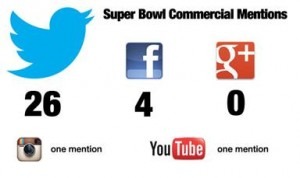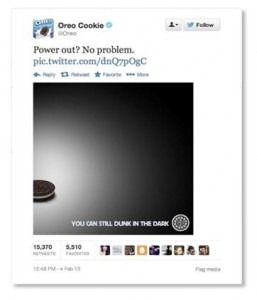As Lori Lewis has reminded Jacobs Media clients and the many readers of her weekly “Merge” column in All Access, you have to understand the various social media platforms in order to benefit from them.
This is especially true in the ongoing discussion about Facebook and Twitter. Lori frequently fields questions about the differences between these two platforms, because so many believe that the relative size of each is the determinant of whether stations or personalities use them. When it comes to Twitter, she’ll tell you that all things being equal, size is mattering less and less.
I have heard many broadcasters use the term “Fish where the fish are” in rationalizing a focus on Facebook over Twitter, but increasingly, this argument misses the point.
Yes, our Techsurveys have indicated a nearly 4:1 difference between the two, so you might be thinking it’s a no-brainer. But when you consider how these platforms are being used by the consumers radio wants to reach, it becomes a different question and a more nuanced argument.
Facebook continues to shine as a very personal platform where consumers share their lives, the histories, and their pictures. The “Timeline” feature – for both people and businesses – suggests a chronological look at our lives and ourselves. And the ability for users to opine for paragraphs is also a defining feature of Facebook – something that we know about all too well as many used their pages in the days and months leading up to the election last November to prattle on about their political beliefs.
This is not to suggest that Facebook station and DJ brand pages are of diminished value. But when you consider that most people go to Facebook to get personal with their “friends,” family members, and tribes, it’s a reminder that Facebook is a very personal place, and that companies and brands need to tread carefully.
And that brings us to the often misunderstood world of Twitter. While it is clearly growing in size and stature, I continue to run into broadcasters who are still hesitant to jump in. While some people do get personal on Twitter (especially celebrities), the bulk of the action is about sharing information and observations about the world around us. Less and less, Twitter is about bad experiences on airplanes and descriptions of meals, and more about exchanging views, links, and ideas.
Twitter is faced with some of the same problems that have beset Facebook and other digital properties – monetization. But it runs much deeper than that. In its effort to define what it does best, there is a very strong move by Twitter to become an appendage, augmenter, and amplifier of the television industry. In fact, some might say that Twitter is providing an entirely new dimension to TV by integrating fan content.
Now you might think that Fac ebook has done this, too, as media companies have built pages for movies, television shows, and special events. But the key to Twitter’s “killer app” is its real-time, concise ability to enhance TV programming as it occurs live.
ebook has done this, too, as media companies have built pages for movies, television shows, and special events. But the key to Twitter’s “killer app” is its real-time, concise ability to enhance TV programming as it occurs live.
The running commentary that now accompanies live events from the Super Bowl to the Grammys has turned regular viewers into pithy, funny, and spot-on reporters and pundits. And the television industry realizes this. When it comes to live television programming, consumers are now watching it together – as they once did as families back in the ’50s (or as an older generation did with the radio decades before that). The difference is that they’re not sitting in the same room, but in a sense they are. Twitter acts as a digital den where an infinite number of viewers, commenters, and wise asses can share their thoughts, witticisms, and insights.
We first saw this on a local level with “The Backchannel,” the Twitter hashtag tribe that provides an entirely different degree of real-time audience interaction with WXYZ-TV News in Detroit, and its anchor team led by Stephen Clark.
And the aforementioned Super Bowl is a case in point. It was the third most watched event in television history. But here’s the most interesting stat: Twitter was mentioned in half of those crazy expensive commercials – 26 of them – compared to only four mentions for Facebook (8% of all ads).
In comparison to last year, each platform garnered 8 mentions. That speaks volumes about momentum.
 Why the difference? Because marketers have figured out that real-time social interaction is what Twitter brings to the coffee table, as consumers use their “second screens” – laptops, phones, and tablets – to interact with the game and the commercials.
Why the difference? Because marketers have figured out that real-time social interaction is what Twitter brings to the coffee table, as consumers use their “second screens” – laptops, phones, and tablets – to interact with the game and the commercials.
And because not everything in a live event goes as planned – like the blackout, for example – these are the moments where Twitter shines. Oreo’s tweet in the middle of the outage took best in show, and the company didn’t have to spend millions of dollars to garner massive attention with its spot-on observation.
As Wharton marketing professor and author Jonah Berger told Wired, “The Super Bowl channel is very saturated. I think a retweet is much more engaged, it is suggesting that the audience is not only processing this message but actively engaging with the message and selecting the message to pass on to their friends. That said, is this going to sell more Oreos at the end of the day? Hard to tell. [But] It definitely makes the brand seem like a more clever, more interesting, sharp brand. So in terms of brand equity this is as effective, if not more effective, than just showing another Super Bowl ad.”
The Twitter brain trust is moving quickly to connect its users with the television they enjoy. Consider the recent deal they put together with Nielsen. It’s about partnering to create a “Nielsen Twitter TV rating” that can be used by both broadcasters and advertisers – an important step in bringing platforms, brands, consumers, and influencers together. This is a great sign for the entire media business.
 And then just a few days ago, Twitter purchased Bluefin Labs, a nearly $100 million investment in a company that bills itself as a social TV analytics operation. As Twitter COO Ali Rowghani pointed out, “We believe that Bluefin’s data science capabilities and social TV expertise will help us create innovative new ad products and consumer experiences in the exciting intersection of Twitter and TV.”
And then just a few days ago, Twitter purchased Bluefin Labs, a nearly $100 million investment in a company that bills itself as a social TV analytics operation. As Twitter COO Ali Rowghani pointed out, “We believe that Bluefin’s data science capabilities and social TV expertise will help us create innovative new ad products and consumer experiences in the exciting intersection of Twitter and TV.”
But this isn’t just a TV thing. There’s a real-time opportunity here for radio – and it goes beyond DJs posting pictures on Twitter. Great shows that aren’t voicetracked and include content dynamics like live in-studio guests, bits, stunts, controversy, and commentary can play in these arenas, too. It’s not for everybody, but for the right shows, the cool events, and the best brands, the real-time power of Twitter isn’t just a possibility – it’s a reality.
And it just might inject some life and in-the-moment currency to radio shows that could use a social and digital jumpstart.
Twitter is becoming TV’s second screen.
Radio operators would be wise to not wait on the sidelines to see what will happen.
- Media And Technology In 2025: Believe It Or Not! - April 18, 2025
- In Radio, You Just Never Know - April 17, 2025
- The Secret To Making A Great Podcast (And Great Radio) - April 16, 2025




While I agree that radio should embrace Twitter – yesterday, I think the lack of activity is emblematic of another issue.
TV has embraced it now and is engaged in twitter, yet much of the original TV twitter activity was spontaneous – people used it to be part of a national conversation because they wanted to weigh in on programming they found engaging.
Why has there been very little spontaneous twitter activity focused on radio? Do the math…
Our belief is that there are enough strong radio shows and personalities that have the power to pull off a real-time Twitter conversation a la The Backchannel. But broadcasters – owners, corporate digital staffs, and personalities – have to embrace it. Thanks, as always, Bob for getting our comments going at an early hour.